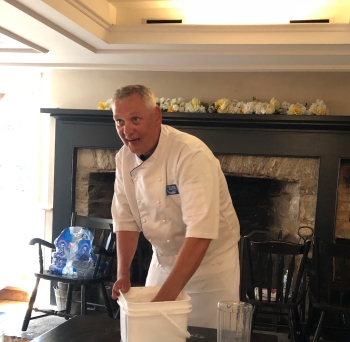
Playing with fire: Baking in a wood-fired oven
October 5, 2018
By Naomi Szeben
 Chef Thorsen Pannek mixes sourdough to be baked in a wood fire oven
Chef Thorsen Pannek mixes sourdough to be baked in a wood fire oven Bakers are always concerned with keeping an eye on future trends while keeping traditions alive, and working with wood-fired ovens meets both concerns.
Chef Pannek, found a way to straddle both the old-fashioned world while keeping his students aware of future trends. With current baking movements veering towards whole grain, wheat-free and yeast-free baking, traditional loaves have found a new market, and Pannek wants to share that knowledge with Canadian chefs.
He sees the future of North American baking going back to more traditional, European methods, and nothing is more traditional than baking in wood fire ovens. However, few schools teach the traditional techniques of working with wood fire, nor give an idea of which breads are best suited to wood ovens.
Chef Thor hopes his students will learn an awareness of traditional methods, specifically the skill of working with wood fired ovens, from this class. He hopes they learn how to “deal with a wood-burning oven,” and how to control the fire and often fluctuating temperatures.
“But also, how to match it with what you’re baking. We’re using a falling temperature, basically. We’re making a pizza, first, at a very high temperature, and then the wood gets swept out and we’ll make two or three products after that, that we match to the temperature.”
Chef Thor’s teaching assistant, Annie Boulanger (whose name, it must be noted, is French for “baker”) shared her tips with Bakers Journal.
Boulanger detailed the logistics of baking in a wood fired oven: The volunteers at Montgomery Inn (known as the “INNovators”) began the fire in the outdoor brick oven at 8:00am. By 10:00 am, they moved the fire to the front, and little by little moved it to the back.
“It’s easier to work with the fire at the front,” explained Boulanger. “Fire is fed by oxygen, so it’s easier to get the fire going. Then, slowly, move the fire to the back to spread the embers, to make sure the oven floor is evenly heated.”
She adds that even an experienced chef can have difficulties measuring the temperature in a wood stove. Once the embers are swept from the oven floor, she doesn’t hesitate to use a 21st-century tool on the 19th-century-style oven. “I use my trusty infra-red thermometer gun to gauge it.”
For those who do not have access to a high-tech thermometer, she does recommend that burgeoning chefs learn to use their senses. “Make sure the embers are spread evenly, so you won’t have a hot spot caused by a fire raging in a corner,” she admonishes. “An even temperature is key, it’s very important to get the embers spread evenly,” adds Chef Thor.
Boulanger adds that even the most quick-handed chef can make a mistake when working with the often unpredictable quality of wood ovens. She recalls a time making pizza, when she burned it to a crisp within seconds. “I was standing right near the oven, and even as I was lifting the dough out, I heard it crackle.” Boulanger shook her head at the memory. “That sound alone let me know I was too late.” She reminds her students that when it comes to fire, to remember “you’re not the boss. The oven is the boss. You need to think about all the variables, like the wind, the ambient temperature, and you deal with that. “It’s important that you’re flexible and you’re able to adapt to what the oven is doing.”
What most people who work with Boulanger don’t know is that she doesn’t have a modern oven range in her home. “All I have is a barbecue and a wood fire oven,” she shares. “There’s always a way to transfer a recipe for an electric range to a wood fire version, or to a barbecue.”
For those without a wood fire oven, she recommends using something called a Tuscan Oven, which is a form of cast iron pan that can be heated in an electric oven. Once it’s warm, it can be placed on the barbecue grill in a preheated barbecue.
What kinds of wood are best for baking in a wood-fired oven? Contrary to popular belief that a sweet-smelling fruitwood yields a fragrant bread, Boulanger recommends avoiding them. Instead, she recommends buying spare bits of hardwood lumber from a yard or using a hardware store that stocks hardwood like oak or maple to be sufficient.
“Save your peach wood or apple wood for meat, if you’re smoking something or roasting meat on a barbecue. For pizza or bread, it’s not going to impart enough flavour. Hardwood is just fine.”
Annie is a sympathetic teacher. She feels that the most important thing for someone to learn when baking in wood fired oven, a zen approach to baking is necessary.
“Like a lot of things in life, you don’t get it right the first time. But it’s good not to get discouraged, and continue because baking with a wood oven is extremely rewarding,” she smiles. “Once you get a wonderful loaf of bread – whether it’s cooked in an oven or a woodfire oven – it’s so wonderful. It’s real magic.”
Print this page